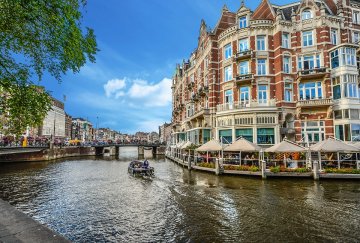Amsterdam started out around the thirteenth century as a fishing village next to the dam that was built on the river Amstel. Over time the town grew and changed its name from “Amsteldam” to “Amsterdam”. Before long the “Amsterdammers” discovered they had a talent for trade and from the fourteenth century onwards trade with the Hanseatic cities flourished.

The Dutch war of independence against the Spanish began in the Sixteenth century. Although originally on the Spanish side, Amsterdam changed sides in 1578. As a result, freedom of religion was reinstated. Religious wars raged throughout Europe and many people looked for a place of refuge where they would not be condemned for their religion. Wealthy Jewish families from Spain and Portugal settled in the Netherlands during these years. Merchants from Antwerp fled the destruction and ransacking of their city by the Spanish. The Huguenots from France sought refuge in Amsterdam so they could practice their religion. But in Amsterdam nobody really had a belief, as long as you were willing to pay your taxes and do your bit for the economy.
The Seventeenth century was Amsterdam’s Golden Age. Amsterdam’s ships sailed to Indonesia, Brazil and Africa, gathering an impressive empire in the process. This was also the same century as Rembrandt and the construction of the Canals. Amsterdam became the most important port of the world and an international center for banking.
The Eighteenth and Nineteenth centuries saw a decline in Amsterdam’s prosperity. Wars against England and France took their tolls on the city and trade with London was completely lost. However, by the end of the Nineteenth century the Industrial Revolution had reached Amsterdam. Waterways to the sea and to the river Rhine improved communication with the rest of Europe and the World. Amsterdam won a new lease on life although it never again achieved the same political and economic dominance it had once enjoyed.
World War I did not affect Amsterdam as the Netherlands remained neutral, although trade and industry suffered. During World War II about 100.000 Jewish people (almost the city’s entire Jewish population) were deported by the Nazis.
The 1960s put Amsterdam back on the map for reasons other than trade. The tolerance of soft drugs made the city an ideal place for the hippie generation. Riots and clashes against the police become common, reaching their high point in 1980 when a battle of protesters against the police fought while Queen Beatrix pledged her oaths to become the new Queen of The Netherlands.
Amsterdam has since become more peaceful and prosperous although it has retained its tolerance of soft drugs and social problems. The city has appeared in many movies and television shows.
